Low molecular weight, non-peptidic agonists of TrkA receptor with NGF-mimetic activity
- PMID: 22764098
- PMCID: PMC3406579
- DOI: 10.1038/cddis.2012.80
Low molecular weight, non-peptidic agonists of TrkA receptor with NGF-mimetic activity
Erratum in
-
Low molecular weight, non-peptidic agonists of TrkA receptor with NGF-mimetic activity.Cell Death Dis. 2012 Sep 6;3(9):e389. doi: 10.1038/cddis.2012.129. Cell Death Dis. 2012. PMID: 22951986 Free PMC article.
Abstract
Exploitation of the biologic activity of neurotrophins is desirable for medical purposes, but their protein nature intrinsically bears adverse pharmacokinetic properties. Here, we report synthesis and biologic characterization of a novel class of low molecular weight, non-peptidic compounds with NGF (nerve growth factor)-mimetic properties. MT2, a representative compound, bound to Trk (tropomyosin kinase receptor)A chain on NGF-sensitive cells, as well as in cell-free assays, at nanomolar concentrations and induced TrkA autophosphorylation and receptor-mediated internalization. MT2 binding involved at least two amino-acid residues within TrkA molecule. Like NGF, MT2 increased phosphorylation of extracellular signal-regulated kinase1/2 and Akt proteins and production of MKP-1 phosphatase (dual specificity phosphatase 1), modulated p38 mitogen-activated protein kinase activation, sustained survival of serum-starved PC12 or RDG cells, and promoted their differentiation. However, the intensity of such responses was heterogenous, as the ability of maintaining survival was equally possessed by NGF and MT2, whereas the induction of differentiation was expressed at definitely lower levels by the mimetic. Analysis of TrkA autophosphorylation patterns induced by MT2 revealed a strong tyrosine (Tyr)490 and a limited Tyr785 and Tyr674/675 activation, findings coherent with the observed functional divarication. Consistently, in an NGF-deprived rat hippocampal neuronal model of Alzheimer Disease, MT2 could correct the biochemical abnormalities and sustain cell survival. Thus, NGF mimetics may reveal interesting investigational tools in neurobiology, as well as promising drug candidates.
Figures
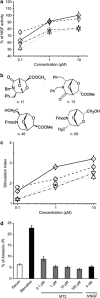
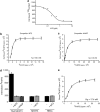


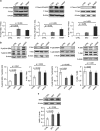
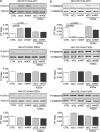
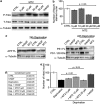
Similar articles
-
Low molecular weight, non-peptidic agonists of TrkA receptor with NGF-mimetic activity.Cell Death Dis. 2012 Sep 6;3(9):e389. doi: 10.1038/cddis.2012.129. Cell Death Dis. 2012. PMID: 22951986 Free PMC article.
-
Nerve growth factor survival signaling in cultured hippocampal neurons is mediated through TrkA and requires the common neurotrophin receptor P75.Neuroscience. 2002;115(4):1089-108. doi: 10.1016/s0306-4522(02)00539-0. Neuroscience. 2002. PMID: 12453482
-
Persistent TrkA activity is necessary to maintain transcription in neuronally differentiated PC12 cells.J Biol Chem. 2003 Oct 31;278(44):42877-85. doi: 10.1074/jbc.M308155200. Epub 2003 Aug 8. J Biol Chem. 2003. PMID: 12909622
-
NGF and ProNGF: Regulation of neuronal and neoplastic responses through receptor signaling.Adv Biol Regul. 2015 May;58:16-27. doi: 10.1016/j.jbior.2014.11.003. Epub 2014 Nov 20. Adv Biol Regul. 2015. PMID: 25491371 Free PMC article. Review.
-
Low-molecular mimetics of nerve growth factor and brain-derived neurotrophic factor: Design and pharmacological properties.Med Res Rev. 2021 Sep;41(5):2746-2774. doi: 10.1002/med.21721. Epub 2020 Aug 18. Med Res Rev. 2021. PMID: 32808322 Review.
Cited by
-
Innovative Therapy for Alzheimer's Disease-With Focus on Biodelivery of NGF.Front Neurosci. 2019 Feb 5;13:38. doi: 10.3389/fnins.2019.00038. eCollection 2019. Front Neurosci. 2019. PMID: 30804738 Free PMC article. Review.
-
Multimodal beneficial effects of BNN27, a nerve growth factor synthetic mimetic, in the 5xFAD mouse model of Alzheimer's disease.Mol Psychiatry. 2025 Jun;30(6):2265-2283. doi: 10.1038/s41380-024-02833-w. Epub 2024 Nov 25. Mol Psychiatry. 2025. PMID: 39587294 Free PMC article.
-
The p75 neurotrophin receptor: at the crossroad of neural repair and death.Neural Regen Res. 2015 May;10(5):721-5. doi: 10.4103/1673-5374.156967. Neural Regen Res. 2015. PMID: 26109945 Free PMC article. Review.
-
The Emerging Therapeutic Role of NGF in Alzheimer's Disease.Neurochem Res. 2016 Jun;41(6):1211-8. doi: 10.1007/s11064-016-1829-9. Epub 2016 Jan 22. Neurochem Res. 2016. PMID: 26801170 Review.
-
The Copper(II)-Assisted Connection between NGF and BDNF by Means of Nerve Growth Factor-Mimicking Short Peptides.Cells. 2019 Apr 1;8(4):301. doi: 10.3390/cells8040301. Cells. 2019. PMID: 30939824 Free PMC article.
References
-
- Barker PA. High affinity not in the vicinity. Neuron. 2007;53:1–4. - PubMed
-
- Wehrman T, He X, Raab B, Dukipatti A, Blau H, Garcia KC. Structural and mechanistic insights into nerve growth factor interactions with the TrkA and p75 receptors. Neuron. 2007;53:25–38. - PubMed
-
- Wiesmann C, Ultsch MH, Bass SH, de Vos AM. Crystal structure of nerve growth factor in complex with the ligand-binding domain of the TrkA receptor. Nature. 1999;401:184–188. - PubMed
Publication types
MeSH terms
Substances
LinkOut - more resources
Full Text Sources
Miscellaneous

